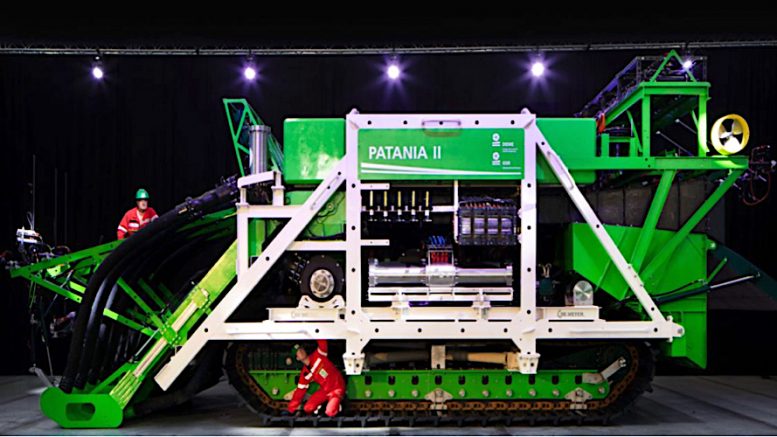Belgium’s Global Sea Mineral Resources (GSR) has resumed tests that could lead to the mining of battery minerals from the Pacific Ocean floor after it managed to recover a robot stranded at a depth of thousands of metres.
The company reported on April 28 that its Patania II, a 25-tonne mining robot prototype, had uncoupled from a 5 km long (3.1 miles) cable connecting it to the surface.
The unit of Belgium’s DEME Group is with a group of European scientists to determine the environmental impacts of deep-sea mining. They are working on GSR’s concession in the Clarion Clipperton Zone.
“It’s ironic that an industry that wants to extract metals from the seabed ends up dropping it down there instead,” Sandra Schoettner, deep-sea biologist from Greenpeace Germany, said in a statement. “This glaring operational failure must act as a stark warning that deep sea mining is too big a risk.”
“We are taking a cautious, step-by-step approach to project development. We conduct these trials to better understand the challenges involved so we can continuously refine our technology,” Kris Van Nijen, managing director of GSR, said in the statement.
“The prototype has functioned well, and learnings will be taken into the next phase of development. This is pioneering engineering work and we were prepared for multiple eventualities,” he noted.
Before this week’s incident, Patania II had had collected potato-sized rocks called “polymetallic nodules”, which are rich in manganese, cobalt and nickel from the seabed.
Mining the ocean floor has been promoted as an alternative to land-based mining, as demand for minerals needed for a green energy transition, such as cobalt and nickel, are set to exceed current production rates by 2030.
DEME Group is among a group of companies, including DeepGreen Metals, Lockheed Martin and China Minmetals, spearheading moves to extract metals needed for electric vehicles and green technologies.
Regulations to support the emerging activity have yet to be agreed upon by the International Seabed Authority (ISA). The UN-backed body of 167 countries has already issued exploration contracts to 21 companies, but they cannot begin mining until regulation is passed.
In 2018, an international team of researchers published a set of criteria to help the ISA protect biodiversity from deep-sea mining activities while it prepares global rules.
According to the U.S. Geological Survey, the deep-sea accounts for more than half the world’s surface and contains minerals in concentrations several times higher than those found in all land reserves combined.
The main target of companies planning to mine underwater are polymetallic nodules. These small rocks, which lie in a shallow layer of mud on the seafloor, are rich in cobalt, nickel, copper, manganese and rare earths.
Scientists and explorers have also identified cobalt-rich crusts, located shallower than nodules and sulphates.
Recent reports, including one commissioned by the High Level Panel for a Sustainable Ocean Economy (Ocean Panel), have called for further research to fill gaps in knowledge before any seabed mining is allowed. They have also argued for the need to set protected zones across all ocean regions under the ISA’s jurisdiction.
The European Parliament has also called for a ban on seabed mining until the environmental impacts and risks of disturbing unique deep-sea ecosystems are understood.
In the resolution, passed three years ago, the legislators also urged the European Commission to persuade member states to stop sponsoring and subsidizing licenses to explore and exploit the seabed in international waters as well as within their own territories.
Conservationists recommend countries encourage the recycling of battery metals to reduce the need of finding new supplies.
Supporters of the activity, however, argue that the extraction of battery metals from the ocean floor could potentially eliminate, or dramatically reduce, most of the environmental and social impacts associated with the extraction of riches from the Earth’s surface.
DeepGreen, one of the companies that are actively seeking to mine the ocean floor, said environmental benefits can be achieved only through collecting polymetallic nodules, 4,000 meters deep on the abyssal plain. At that depth, life is up to 1,500 times less abundant than in the vibrant ecosystems on land from where battery metals are currently sourced, the Canadian firm noted.
Nodules lie unattached on the seafloor and DeepGreen says its approach to collecting them differs from other extractive processes that could affect the integrity of the seafloor crust, as explained by the World Wildlife Fund (WWF).
In March, BMW, Volvo, Google and Korean battery maker Samsung SDI, announced that they will not buy metals extracted through deep-sea mining until the environmental risks of the activity are “comprehensively understood.”


Be the first to comment on "Deep-sea mining tests resume as lost robot rescued"